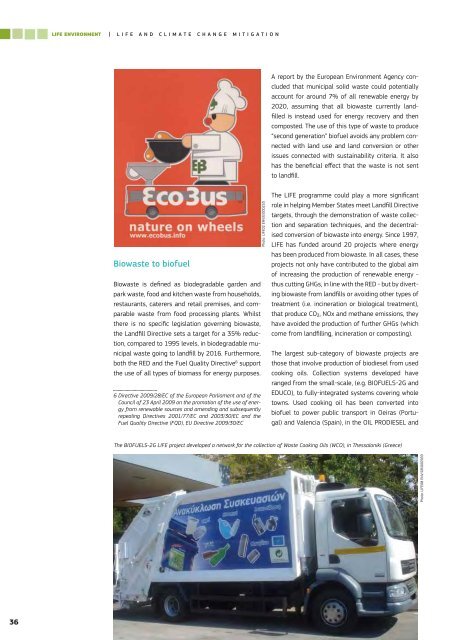Create successful ePaper yourself
Turn your PDF publications into a flip-book with our unique Google optimized e-Paper software.
LIFE ENVIRONMENT |LIFE and Climate CHANGE mitigationA report by the European Environment Agency concludedthat municipal solid waste could potentiallyaccount for around 7% of all renewable energy by2020, assuming that all biowaste currently landfilledis instead used for energy recovery and thencomposted. The use of this type of waste to produce“second generation” biofuel avoids any problem connectedwith land use and land conversion or otherissues connected with sustainability criteria. It alsohas the beneficial effect that the waste is not sentto landfill.Biowaste to biofuelBiowaste is defined as biodegradable garden andpark waste, food and kitchen waste from households,restaurants, caterers and retail premises, and comparablewaste from food processing plants. Whilstthere is no specific legislation governing biowaste,the Landfill Directive sets a target for a 35% reduction,compared to 1995 levels, in biodegradable municipalwaste going to landfill by 2016. Furthermore,both the RED and the Fuel Quality Directive 6 supportthe use of all types of biomass for energy purposes.6 Directive 2009/28/EC of the European Parliament and of theCouncil of 23 April 2009 on the promotion of the use of energyfrom renewable sources and amending and subsequentlyrepealing Directives 2001/77/EC and 2003/30/EC and theFuel Quality Directive (FQD), EU Directive 2009/30/ECPhoto: LIFE02 ENV/E/000253The LIFE programme could play a more significantrole in helping Member States meet Landfill Directivetargets, through the demonstration of waste collectionand separation techniques, and the decentralisedconversion of biowaste into energy. Since 1997,LIFE has funded around 20 projects where energyhas been produced from biowaste. In all cases, theseprojects not only have contributed to the global aimof increasing the production of renewable energy -thus cutting GHGs, in line with the RED - but by divertingbiowaste from landfills or avoiding other types oftreatment (i.e. incineration or biological treatment),that produce CO2, NOx and methane emissions, theyhave avoided the production of further GHGs (whichcome from landfilling, incineration or composting).The largest sub-category of biowaste projects arethose that involve production of biodiesel from usedcooking oils. Collection systems developed haveranged from the small-scale, (e.g. BIOFUELS-2G andEDUCO), to fully-integrated systems covering wholetowns. Used cooking oil has been converted intobiofuel to power public transport in Oeiras (Portugal)and Valencia (Spain), in the OIL PRODIESEL andThe BIOFUELS-2G LIFE project developed a network for the collection of Waste Cooking Oils (WCO), in Thessaloniki (Greece)Photo: LIFE08 ENV/GR/00056936


